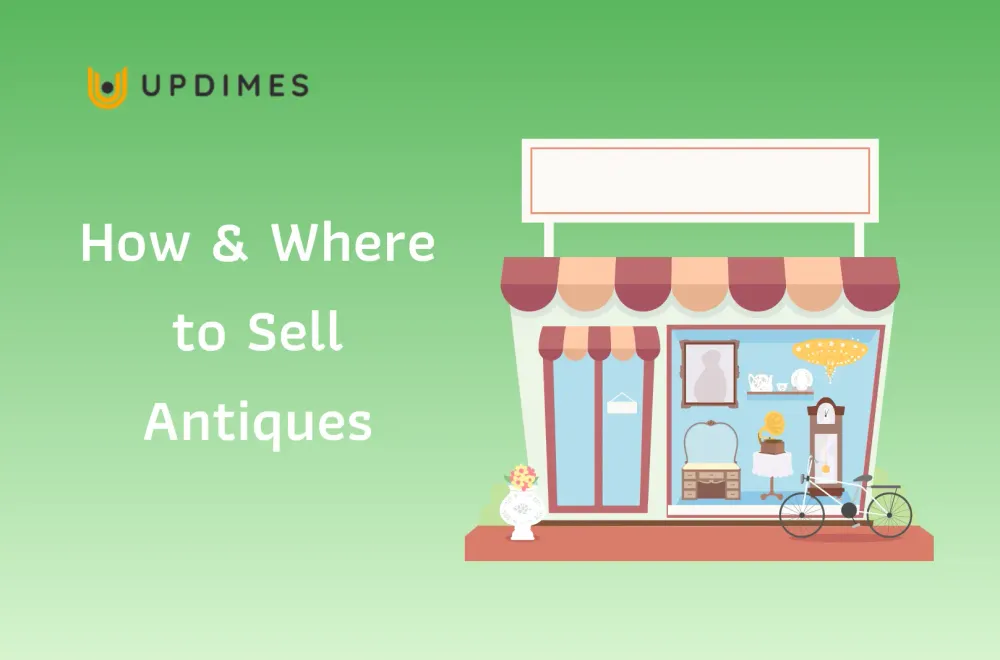How & Where to Sell Antiques: A Complete Guide

In a world filled with mass-produced goods, antiques hold a special allure. Whether it's a vintage piece of furniture, a delicate porcelain figurine, or a rare collectible, antiques possess a unique charm that transcends time. If you find yourself in possession of these cherished relics, you may be wondering how and where to sell them.
In this article, we will provide valuable insights into antiques and a comprehensive guide on how and where to sell antiques to unlock the true value of your treasures.
Now, let’s get started!
Selling Antiques 101 - All You Need to Know
What are antiques?
Antiques are items that are at least 100 years old and possess historical, aesthetic, or cultural significance. These objects, such as furniture, jewelry, artwork, and books, showcase exceptional craftsmanship and the value of antiques based on their rarity and age. Antiques offer a tangible connection to the past, captivating collectors and enthusiasts with their unique charm and historical importance.
Understand antique market - Is selling antiques worth it?
Navigating the antique market requires a comprehensive understanding of its intricacies. Before deciding to sell antiques, it's essential to evaluate whether it's worth the effort and investment.
Evaluating the Worth
Before selling antiques, it's crucial to assess whether it's worth the effort and investment. Consider the following factors:
- Rarity: The scarcity of an antique item contributes to its value. Rare pieces are highly sought after by collectors.
- Condition: The overall state of the item, including any damage or restoration, affects its desirability and price.
- Historical Importance: The historical significance or association with notable events or figures can significantly increase an antique's value.
- Market Demand: Research current market trends and demand for specific types of antiques to gauge potential interest and pricing.
Challenges
While selling antiques can be a profitable venture, it is not without challenges.
- Market Fluctuations: The market can fluctuate, and finding the right buyer willing to pay the desired price may require patience and strategic marketing. Factors such as economic conditions, trends, and shifts in popular collecting categories can impact market demand and value.
- Costs and Expenses: Selling antiques may incur costs, including restoration, professional appraisals, marketing, and fees associated with online platforms or auction houses. These expenses should be considered when determining the profitability of selling antiques.
- Targeting the Right Buyers: Finding the right buyer is crucial to obtaining the desired price for an antique. Understanding the preferences and interests of potential buyers, such as collectors, dealers, or specialized auctions, can help effectively market the item.
- Emotional Attachment: Consider any sentimental value attached to the antique. If it holds significant personal or family history, selling it may not align with sentimental considerations.
Where to Sell Antiques Online?
Sell on social media
Social media platforms have become popular and powerful tools for connecting with potential buyers and promoting antiques. Here are three popular platforms where you can sell antiques online:
With its massive user base, Facebook offers several options for selling antiques online.
- Facebook Marketplace: List your antiques for sale in your local area, or expand your reach to nearby regions. Take advantage of Facebook's search filters and categories to make it easier for interested buyers to find your items.
- Facebook Groups: Join antique-related groups or create your selling group. Engage with members, share photos, and negotiate prices directly. These groups attract enthusiasts who are actively seeking unique pieces.
Known for its visual focus, Instagram provides an excellent platform to showcase your antiques and engage with potential antique buyers.
- Dedicated Selling Account: Create a separate Instagram account dedicated to selling antiques. Post high-quality photos, use relevant hashtags, and provide detailed descriptions to capture the attention of antique enthusiasts.
- Engage with the Community: Follow and engage with other antique sellers, collectors, and influencers. Participate in antique-related conversations, share stories, and collaborate with influencers to expand your reach.
TikTok
This rapidly growing video-sharing platform offers a unique way to showcase and sell antiques.
- Create Engaging Content: Film short videos showcasing your antiques, highlighting their unique features, and sharing interesting stories. Utilize trends, challenges, and engaging storytelling to capture the attention of viewers.
- Direct Viewers to Selling Platforms: Include links or references in your TikTok bio or video captions to redirect interested buyers to your preferred selling platforms, such as online marketplaces or your own website.
Sell directly to online dealers
Another option for selling antiques online is to connect directly with online dealers who specialize in buying and selling unique items.
- Research and identify reputable dealers: Look for online dealers who specialize in your specific type of antique. Read reviews, check their reputation, and verify their credibility before engaging in any transactions.
- Contact the dealer: Reach out to the dealer directly through their website or contact information provided. Share detailed information, including photos and descriptions, to facilitate their evaluation of your antique.
- Negotiate fair prices: Online dealers are experienced in assessing the value of antiques. Be prepared to negotiate and consider their offered price based on their market expertise. Ensure transparency and ask for references or certifications when necessary.
Sell on marketplaces
Online marketplaces provide a wide-reaching platform to sell antiques to a global audience. Consider these popular marketplaces:
Etsy
Etsy is an excellent best place to sell antiques online because it focuses on selling handmade and vintage items.
- Create a shop: Set up an online shop on Etsy and showcase your antiques with detailed descriptions and high-quality photos.
- Targeted community: Etsy attracts a community of buyers interested in unique and vintage pieces. Take advantage of this niche market by utilizing relevant keywords, tags, and categories.
eBay
Considered one of the largest online marketplaces in the world, eBay offers a broad audience and various selling options for antiques.
- Auctions and Fixed Prices: List your antiques for auction-style bidding or set a fixed price. Consider the demand and rarity of your items to determine the most effective selling format.
- Detailed Listings: Provide accurate descriptions, condition reports, and multiple photos to attract potential buyers. Be transparent about any flaws or damages.
Ruby Lane
Ruby Lane is a curated online marketplace where to sell collectibles online because it specializes in antiques, vintage items, and art.
- Selective platform: Ruby Lane has a reputation for high-quality, curated listings. Apply to become a shop owner and ensure your items meet their criteria.
- Niche audience: Ruby Lane attracts serious antique collectors and enthusiasts. Tailor your listings to appeal to this audience, providing comprehensive descriptions and detailed information about the history and provenance of your antiques.
Other Marketplaces
Explore additional online marketplaces like Chairish, 1stDibs, and Bonanza. Each platform offers unique features, target audiences, and selling options. Research their terms, fees, and policies to determine the best fit for your antiques.
Create websites
When you want to create a eCommerce sites to sell antiques, you should use the most popular eCommerce platforms like Shopify and Wix because they offer several advantages.
Shopify
Shopify is a popular choice for creating an online antique store due to its comprehensive eCommerce features and user-friendly interface. Here are the reasons to choose Shopify:

- User-friendly interface with a drag-and-drop website builder for easy store setup and management.
- Robust eCommerce features, including inventory management, order tracking, and secure payment options.
- Customizable templates and themes to create a visually appealing and unique online antique shop.
- Mobile-responsive design ensures optimal browsing experience on smartphones and tablets.
- Extensive App Store with a large range of integrations to enhance store functionality and marketing capabilities.
- Dedicated customer support and reliable hosting for seamless operation of your online store.
Wix
Wix is a versatile website builder that offers flexibility and ease of use, making it a suitable choice for creating an online store to sell antiques. Here are the reasons to choose Wix:

- Intuitive website builder with drag-and-drop functionality for easy customization and design flexibility.
- Mobile optimization ensures a seamless browsing experience on mobile devices.
- App Market with a variety of integrations to enhance store functionality and customer experience.
- Affordable pricing plans, including budget-friendly options, suitable for small businesses or individuals starting an online antique store.
- Built-in SEO tools to optimize your store's visibility in search engine results.
- Reliable hosting, security features, and customer support for smooth operation of your online store.
Where to Sell Antiques Near Me?
If you're looking to sell your antiques locally, there are several options available to you. Here are some common places where you can sell antiques near you:
Consignment shops
Consignment shops are a popular choice for selling antiques. These stores allow you to display your items for sale while the shop takes a commission from the sold items. Consignment shops often have a dedicated customer base interested in unique and vintage pieces.
Newspaper listing
Traditional newspaper listings can still be effective for reaching local buyers. Many newspapers have classified sections specifically for antiques and collectibles. You can place an ad describing your items for sale and include your contact information for interested buyers to reach out to you.
Flea markets
Flea markets are bustling marketplaces where vendors sell a variety of items, including antiques. With a booth at a local flea market, you can easily showcase your antiques directly to potential buyers. Flea markets attract a diverse range of shoppers, including antique collectors near me and antique enthusiasts.
Antique shows
Antique shows and fairs bring together antique dealers and collectors in one location. These events typically attract a concentrated audience of people interested in antiques. Renting a booth or table at an antique show lets you directly interact with potential buyers and showcase your items.
Antique malls
Antique malls are large establishments that house multiple antique dealers under one roof. Renting space within an antique mall gives you the opportunity to display your antiques alongside other sellers. These malls often have a steady stream of customers browsing through various booths, increasing the chances of finding interested buyers.
Craft fairs
While primarily focused on handmade crafts, some craft fairs also welcome vendors selling vintage and antique items. Craft fairs can attract a wide range of visitors interested in unique and eclectic pieces. Research local craft fairs in your area and inquire about their acceptance of antique vendors.
How to Sell Antiques Items?
Selling antique items requires careful planning, research, and effective marketing strategies. Here is a step-by-step process to help you sell your antique items successfully:
Step 1: Research and assess your items
Begin by researching and assessing your antique items. Gather information about their origin, history, materials, and any unique features or markings. Determine their rarity, condition, and estimated market value.
Consult antique reference books, online resources, and professional appraisers to obtain accurate and detailed information about your items.
Step 2: Determine selling strategy
Consider the different selling options available to you, such as online platforms, local venues, or working with antique dealers. Evaluate each option based on your specific items, target audience, and personal preferences.
Step 3: Set a fair price
Price your antique items based on their rarity, condition, demand, and current market value. Research recent sales of similar items to get a sense of their market worth.
Consider factors like any restoration costs, fees associated with selling platforms or venues, and potential negotiation room when setting the price.
Step 4: Clean and restore
Before listing your items for sale, ensure they are clean and well-presented. Use gentle cleaning methods appropriate for the material and age of the item. If necessary, consider professional restoration to enhance their appearance and value. Always consult experts for restoration advice to avoid damaging valuable antiques.
Step 5: Capture high-quality product images
Take clear, well-lit photographs of your antique items from various angles to showcase their unique features and condition. Use a neutral background and avoid excessive editing or filters that may distort the item's appearance. High-quality images are essential for attracting potential buyers.
Step 6: Write detailed descriptions
Craft informative and accurate descriptions for each antique item you plan to sell. Include relevant details about its history, provenance, age, materials, dimensions, and any notable features. Be transparent about any flaws, repairs, or restorations.
Use captivating language and storytelling techniques to engage potential buyers and highlight the significance or appeal of the item.
Step 7: Choose selling channels
Determine the most suitable selling channels based on your target audience and the type of antique items you have. Options include online platforms, local venues, antique shows, or working with dealers.
- Online platforms: Consider reputable websites like Etsy, eBay, Ruby Lane, or dedicated antique forums. Create detailed listings with your high-quality photos and descriptions.
- Local venues: Explore consignment shops, antique malls, flea markets, or craft fairs in your area. Rent booth space or work with established venues to display and sell your antiques.
Step 8: Promote your items
Utilize effective marketing strategies to promote your antique items and attract potential buyers.
- Online platforms: Optimize your listings with relevant keywords, utilize social media platforms to share your listings, and engage with online antique communities.
- Local venues: Promote your presence at local venues through social media, local advertisements, and community bulletin boards.
Step 9: Engage with potential buyers
Respond promptly to inquiries, provide additional information or photographs upon request, and maintain open communication with potential buyers.
Be prepared to negotiate prices or consider reasonable offers. Establish a fair and transparent transaction process, including payment methods and shipping options.
Step 10: Packaging and shipping
Safely package your antique items to protect them during shipping. Use appropriate materials, such as bubble wrap, padding, or sturdy boxes. Consider insurance for high-value or fragile items. In this case, you can learn about smart packaging ideas for small businesses.
Regarding shipping, you should choose reputable shipping carriers and track the packages to ensure safe and timely delivery. Besides, you need to provide tracking information to buyers and follow up to ensure their satisfaction.
Step 11: Follow-up and feedback
After the sale, follow up with buyers to ensure their satisfaction with the purchased antique items. Address any concerns or issues promptly and professionally.
You can send them emails to request buyer feedback and encourage them to leave reviews. Positive reviews can enhance your reputation and attract future buyers.
Remember, selling antique items requires patience and persistence. It's essential to continually evaluate and adjust your selling strategy based on market trends, customer feedback, and your own experience. Stay knowledgeable about the antique market and be open to learning and adapting as you navigate the process of selling your valuable antiques.
Where to Sell Antiques - FAQs
Where can I sell my collectors items?
You can sell your collectors items on various platforms. Online options include eBay, Etsy, and specialized collectors' forums. Auction houses and consignment shops are other possibilities. Consider local collectors' clubs, events, trade shows, and conventions. Additionally, you can explore social media groups or create your own website to reach potential buyers.
How do I sell my antiques privately?
To sell antiques privately, use online classifieds, social media platforms, or create a website. Advertise with detailed descriptions and high-quality photos. Engage with potential buyers directly, negotiate prices privately, and arrange secure payment methods and shipping.
How do I find out what my antiques are worth?
Determining the value of antiques requires research. Consult professional appraisers, reference books, or online valuation resources. Research recent sales of similar items and seek advice from antique forums or communities. Valuation is influenced by rarity, condition, provenance, and market demand.
Is there a free app to identify antiques?
There are free apps available to help identify antiques, such as "Antique Identification" and "What's It Worth?". These apps enable you to upload photos and descriptions for identification and provide information on similar items and potential values. However, it's recommended to consult experts for accurate identification and valuation.
How do I sell collectible items?
To sell collectible items, use online platforms like eBay, specialized collectors' forums, or dedicated collectible marketplaces. Create detailed listings with descriptions and high-quality photos. Engage with collectors' communities, promote through social media, and offer secure payment and shipping options to attract interested buyers.
Final Words on How & Where to Sell Antiques?
In conclusion, selling antiques requires careful consideration of various factors such as the type of items, target audience, and preferred selling methods. By utilizing a combination of online platforms, local venues, and private sales, you can effectively reach potential buyers and maximize your chances of success. Conduct thorough research, present your items attractively, and engage with potential buyers through compelling descriptions and high-quality visuals.
With patience, persistence, and a well-planned selling strategy, you can navigate the world of antique sales and find the right avenues to showcase and sell your cherished pieces.
